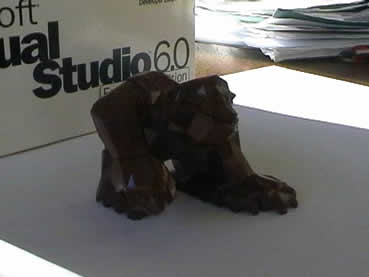|
|
 |
|
|
Building your masterpiece is only half of the problem; a poor photo can
ruin a great model. Here are some tips on how to get the best out of your
camera.
[All photos were taken using a digital camera]
We'll start by looking at the presentation of the photograph. Look at the
photo on the right. I t has a nice clean background, and you can clearly see
the monster. However, have a look at the next photograph below, and you'll
see the devastating effects that background clutter can have on a photograph. |
 |
|
So rule number one is:
Legoweb's First Principle of Lego
Photography: Always
clear out the background of the image to make the subject more visible. |
There are three good ways to create a nice background for your image. Firstly,
you can use a sheet of white paper (A3 is best), which you curve up behind
the image to create a smooth background. [See example]
Secondly, you can use Lego boards to create a stud background for the image.
[See example]
Finally, you can do whatever you like and edit the image in a graphics package
once it is on the computer. |
 |
|
If you cannot get hold of any large white paper or Lego brick boards, than
a textured carpet is often just as effective. Choose a spot away from any spills,
muck or stains to make the image look more professional.
|
 |
|
Next, when taking a
photograph, you need to be aware of how the light is falling on the picture.
Compare the photo on the right with the one below:
In the first photo, the camera is between the monster and the sun. In the
second picture, the monster is between the camera and the sun. This has produced
a 'lens flare' effect on the photograph which is a problem for both digital
and non-digital cameras. The first photograph has the sun shining directly
onto it, producing a nice effect of light and dark patches, and crisp, even
lines |
 |
So therefore, my second rule is:
Legoweb's Second Principle of
Lego Photography: Always photograph looking away from
a direct source of light.
|
I also ought to mention a couple of other things here. Firstly, natural
light is nearly always better than artifical light, which can produce unusual
discolouration effects when taking a photograph. Secondly, you should always
be aware of shadows when taking the photo (see below). |
 |
|
Although shadows can often be very good for creating effects on photographs,
but sometimes they can just be really annoying. You need to beware of shadows
from three sources:
• The object you are photographing
• Other objects in the picture
•
You and your camera.
Look at the photograph to see the devastating effects that shadows can have.
Consequently, my third rule is:
Legoweb's Third Principle of Lego
Photography: Beware of shadows cast by you or your subject
in your photographs.
|
|
 |
|
Also, beware of taking your whole photograph when it is in shadow. The image
will appear very dull and black, with little or no definition and colour.
|
 |
|

